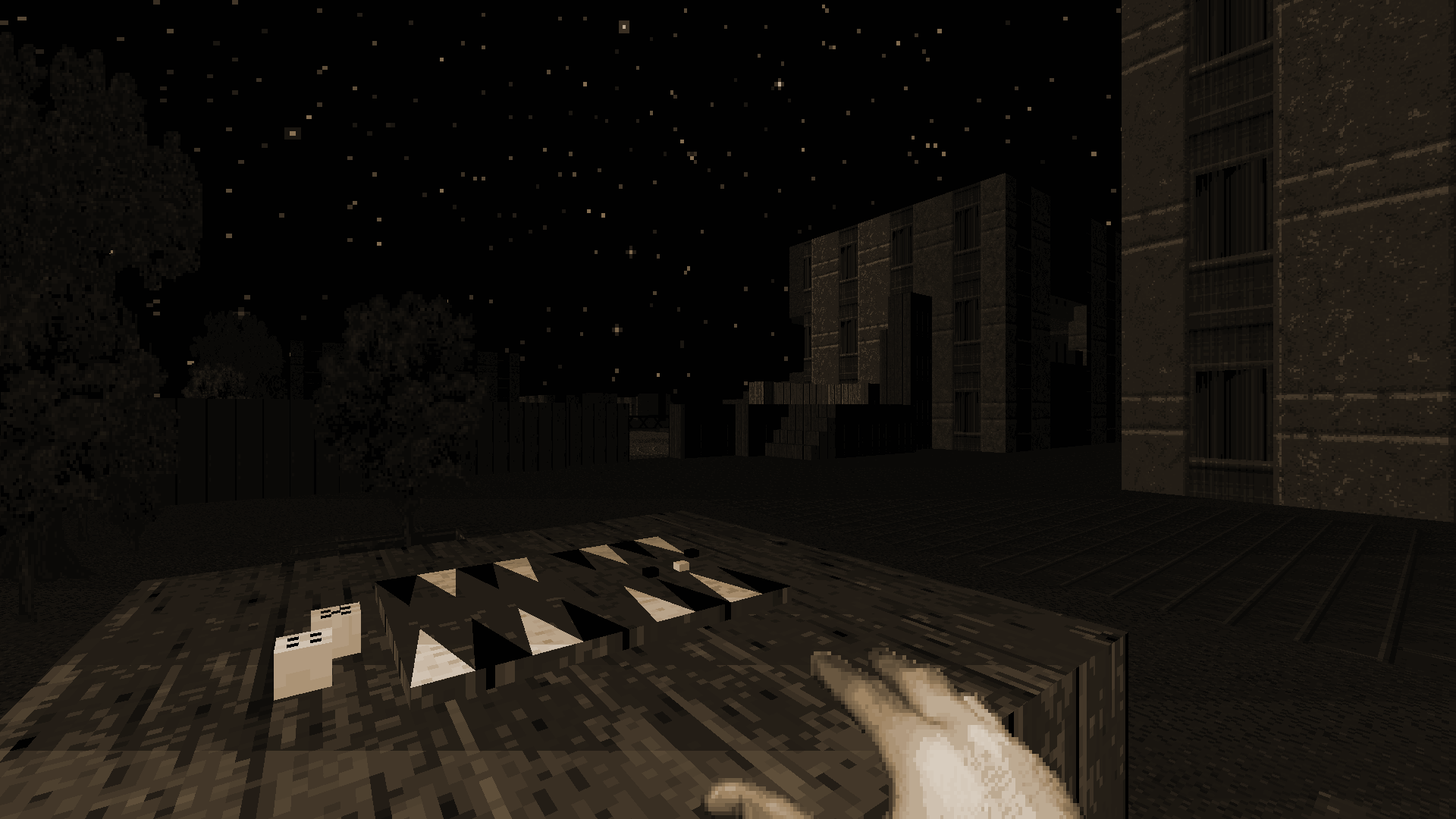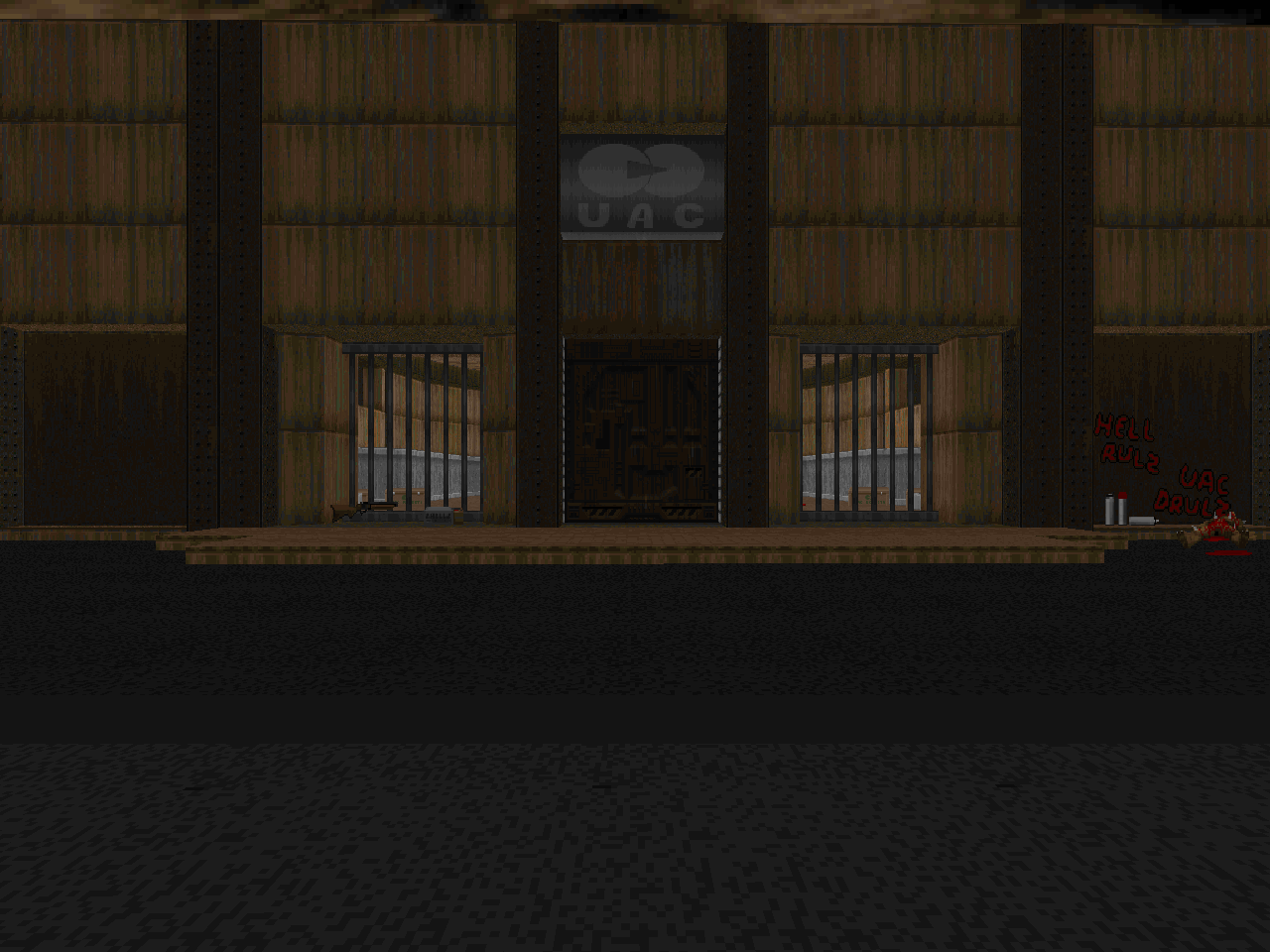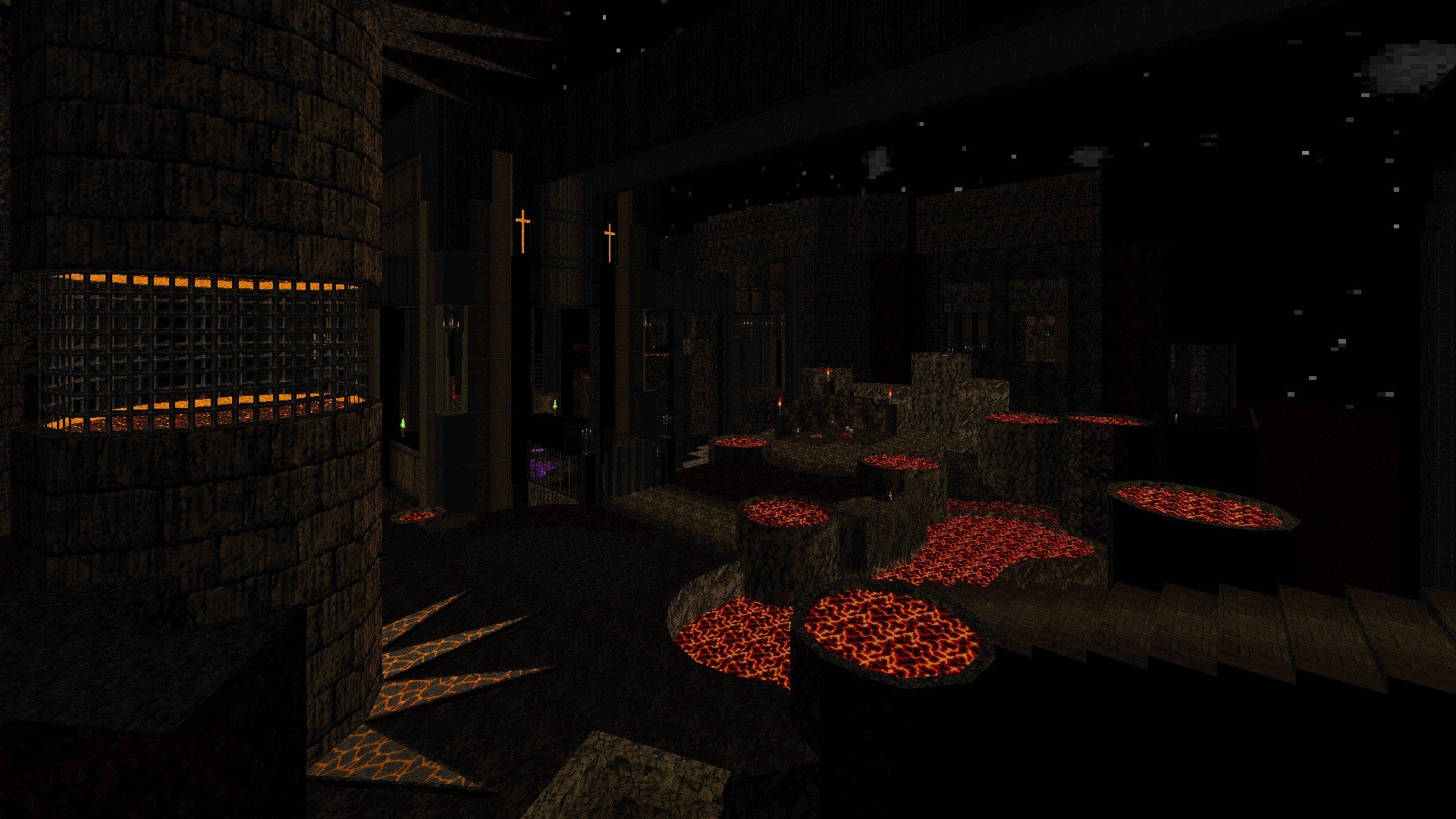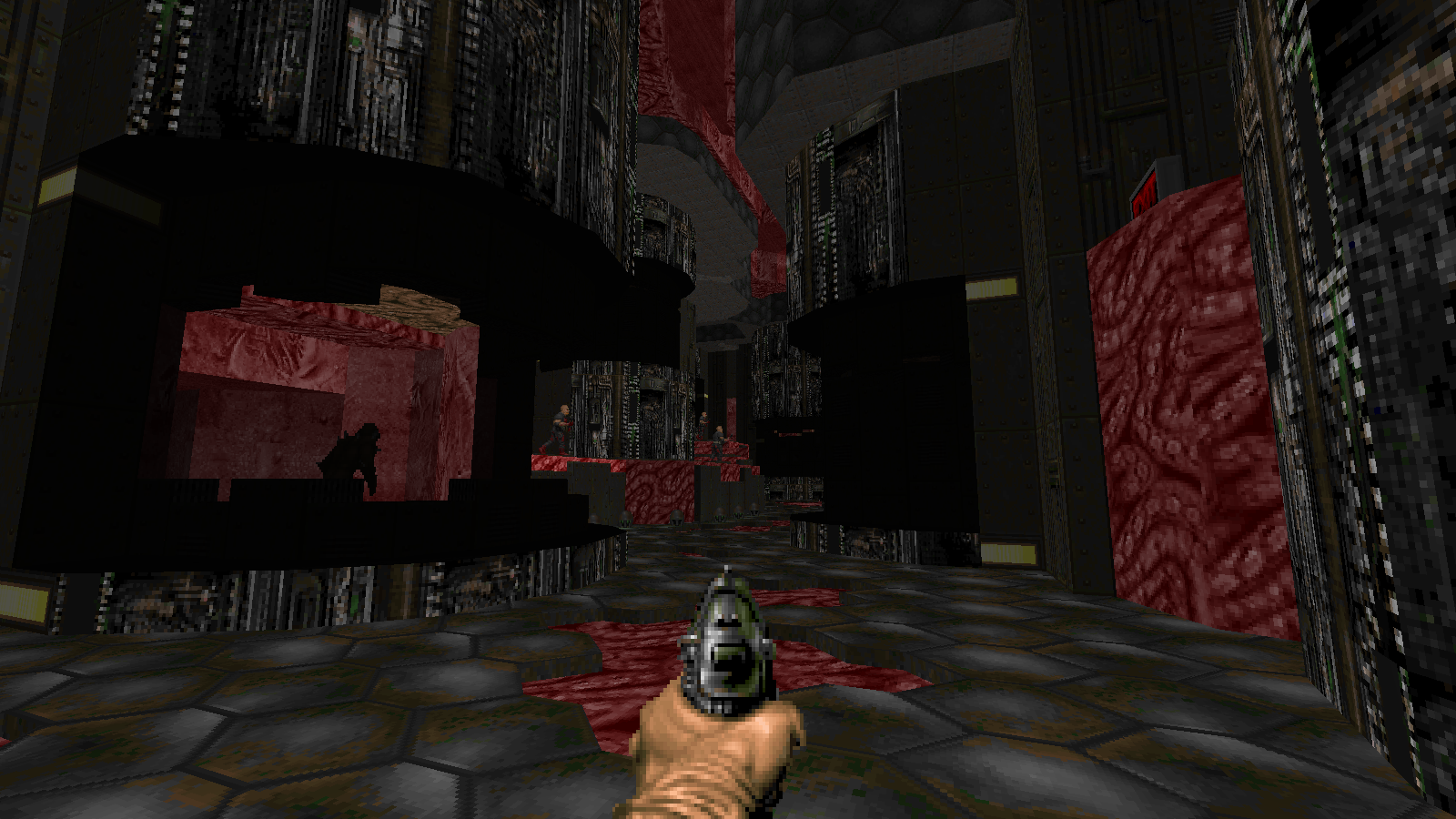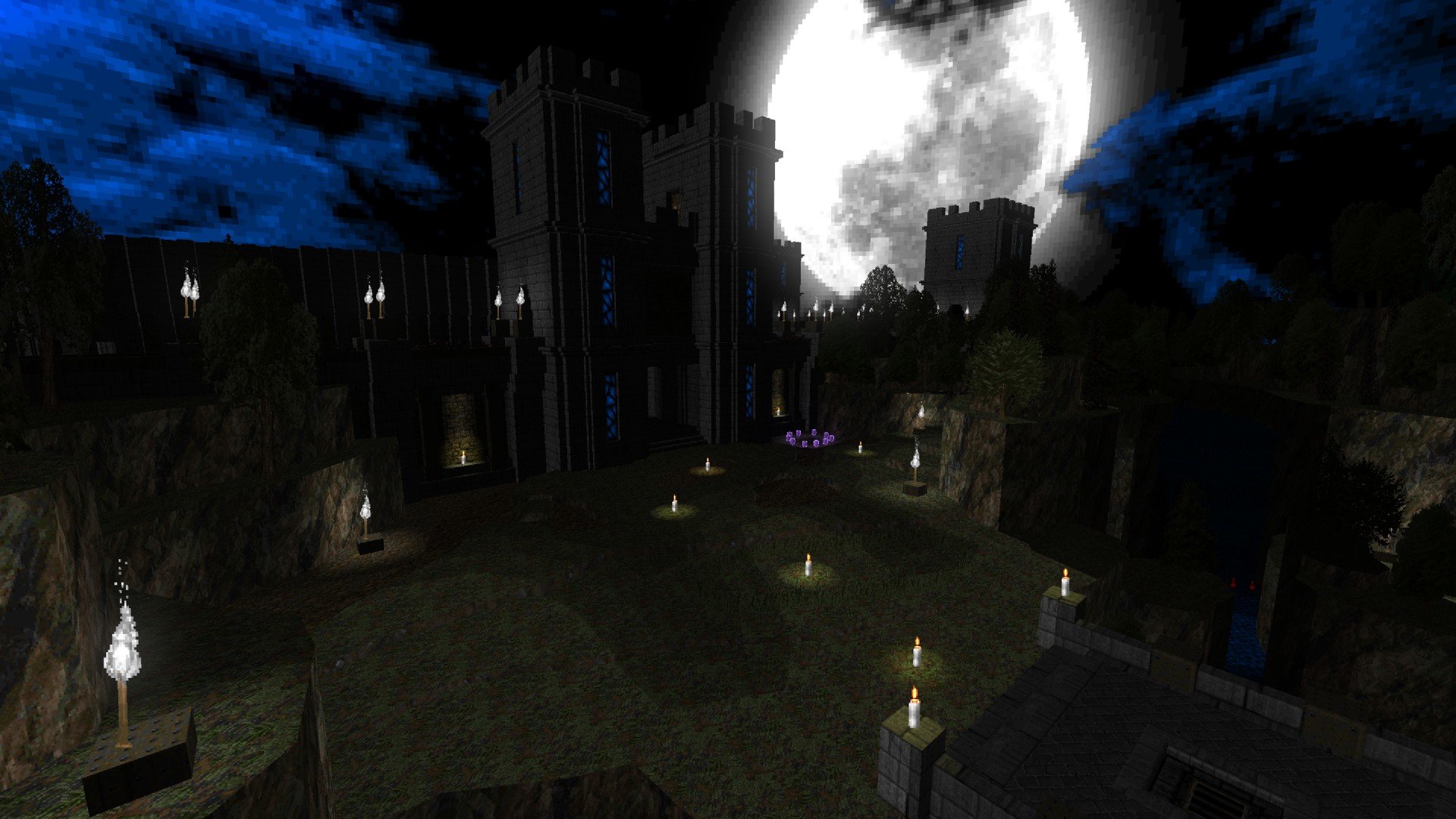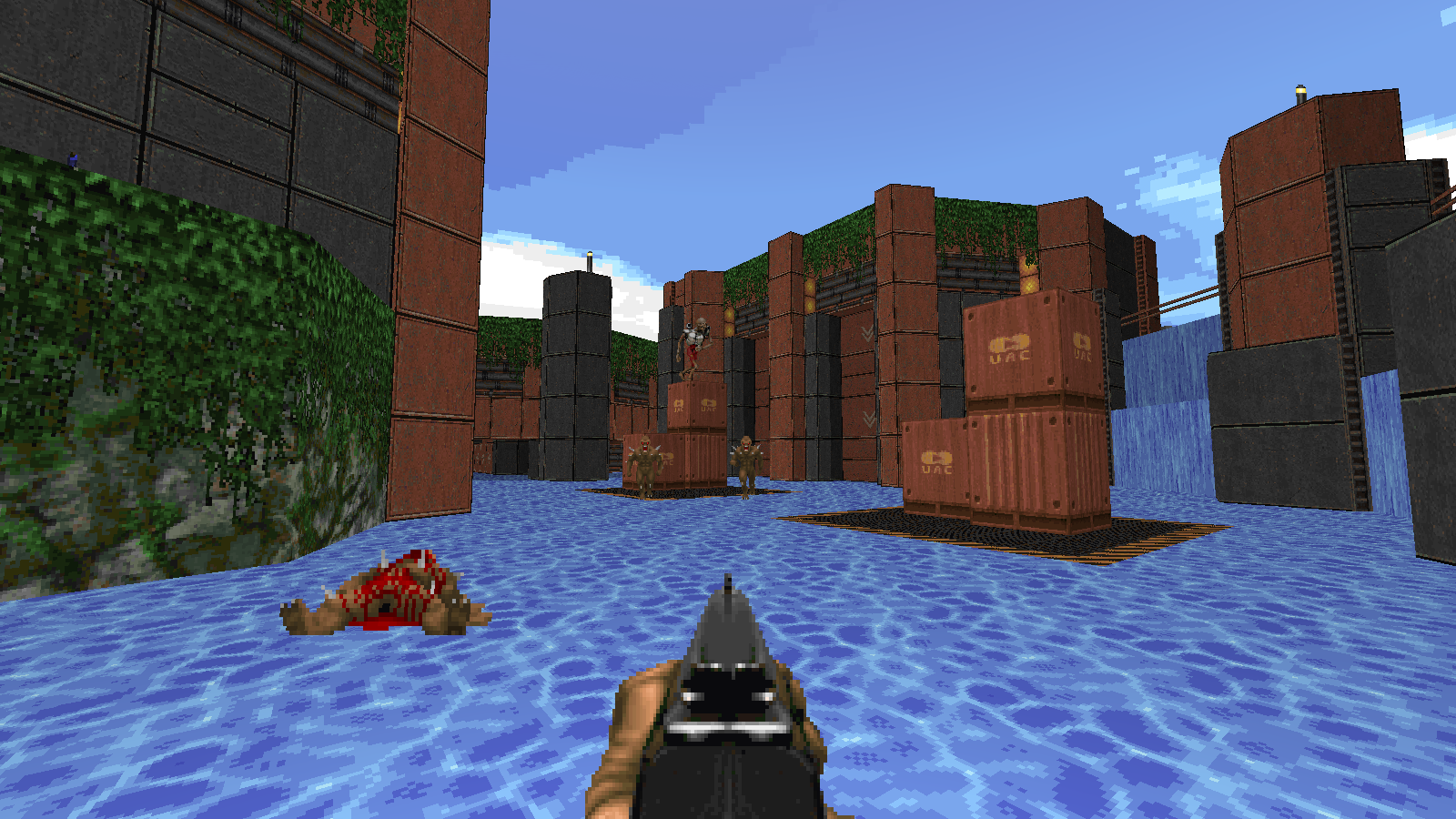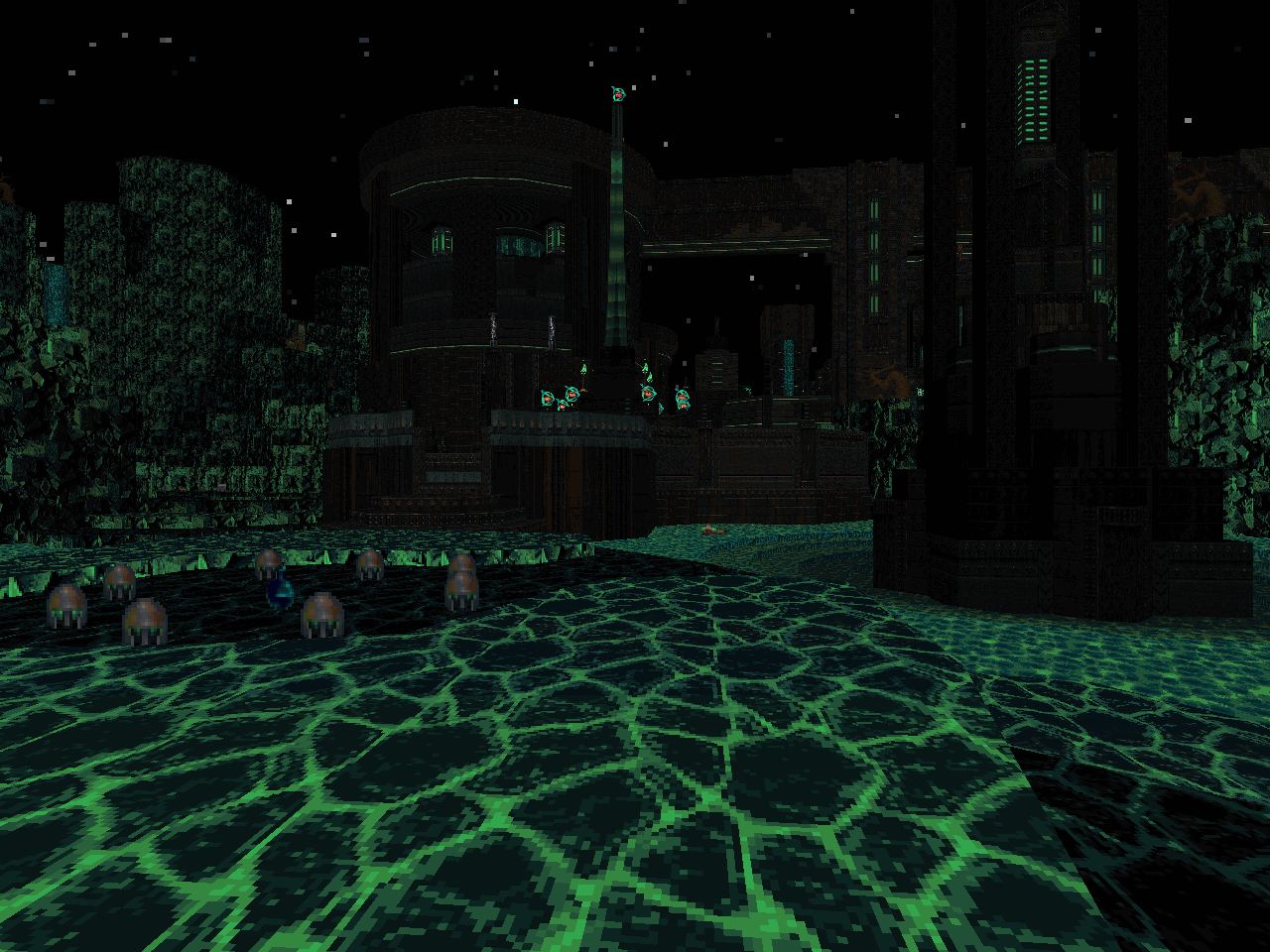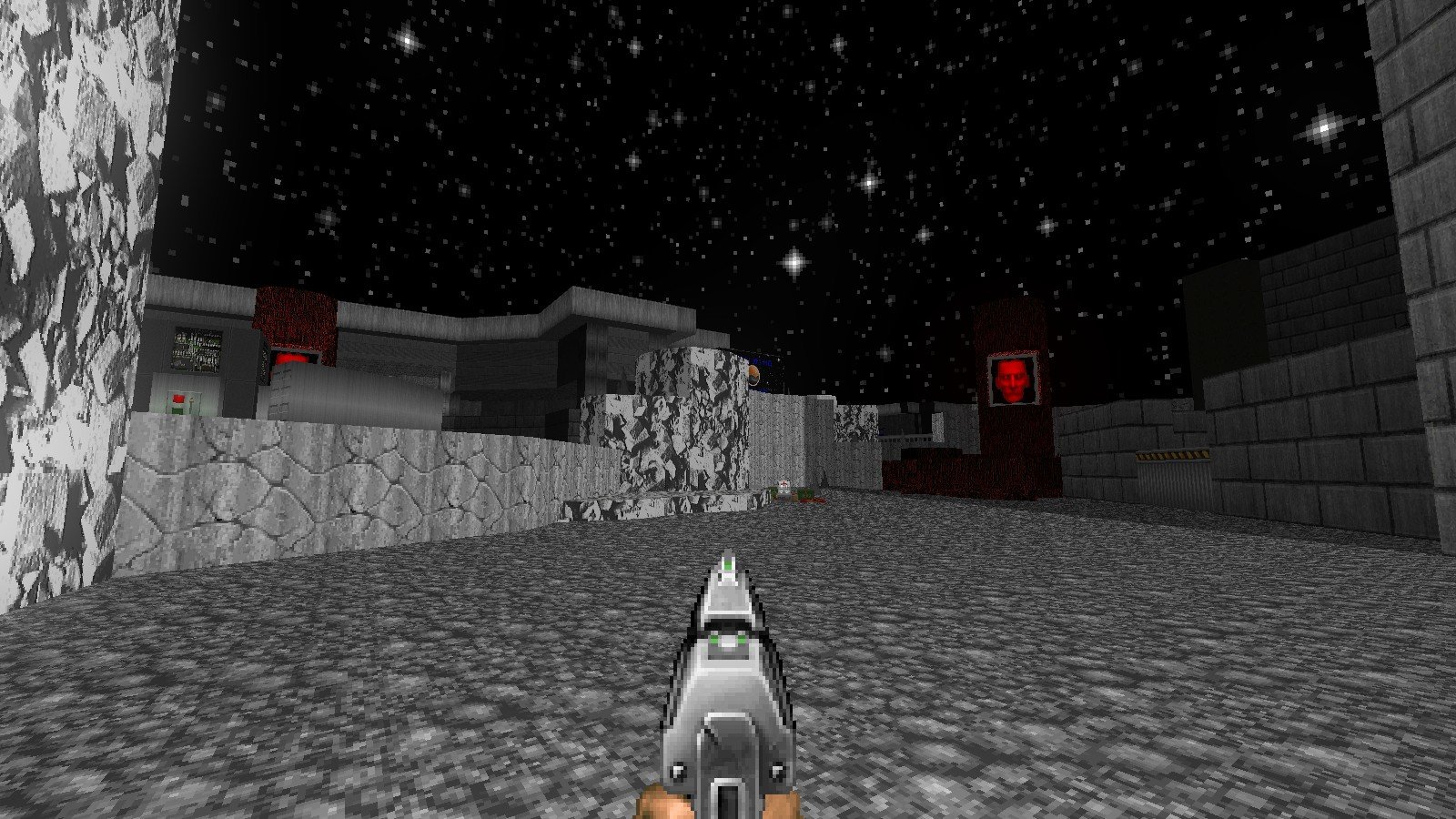-
Doom 2, MBF21, 34 maps
Beginning as a small project for last year's NaNoWADMo event, Sepia eventually grew into a full campaign, epic in both scope and sweep, beginning in the mud and blood of the trenches of an alternate history Great War, and ending in a dusty, echoing attic-space beyond all borders of time and reality.
The most immediately striking quality of Sepia is, of course, its namesake custom palette. All of the world's colors are shifted to a beige/brown/black scale meant to simulate the look of a late 19th century photograph, an effect which imbues the game's variously grim and rustic scenery with contrasting emotive tones of melancholy and desolation, and yet also an odd sort of warmth. The care on the designer's part to maintain readability in the action and environments with respect to this bold creative choice certainly should not be underestimated, but I assure you, it's really only the tip of the iceberg as far as the mapset's penchant for engrossing and unusual ideas is concerned.
Indeed, there's truly no earthly way of predicting just where Sepia will take you next. The opening WWI theme, novel in itself, eventually and unexpectedly gives way to buried ruins of an unnervingly anachronistic cast. Perhaps, in a bid to carve out an extensive underground garrison sheltered from artillery and gas, one of The Conflict's belligerents delved too deep, unwittingly uncovering a subterranean sanctum for slumbering powers best left undisturbed, which in their desperation and hubris they attempted to weaponize against their foes, ultimately serving only to plunge the battlefields into an even more hopeless nightmare. As the mystery deepens, a sense of unreality steadily creeps in -- a buried ballroom hosts a phantasmal danse macabre, a landscape portrait becomes an astral window on a black magic ritual held under cold stars long ago, and our protagonist finds himself formally on trial for one of his (admittedly numerous) acts of wanton aggression. And then shit really gets weird, as an unearthed monolith flings open the doors to a primeval ante-plane beyond mortal ken, where the mounting surrealism collapses wholesale into brutalist hyper-abstraction, a tidal wave of cubist alien geometry and unfeeling white void threatening to spill out and drown our planet.
Along the way, the action is just as varied and unpredictable as the setting. In the early going, squalid networks of trenches and bunkers, bombed-out shells of towns and villages, and other realistic locales dominate. In this type of environment, with plentiful solid cover and definite (if often numerous) avenues of fire and approach both into and out of most locations, you'll frequently find yourself stolidly holding the breach, weaponizing and strategizing around wartime features like minefields, demolition charges, and pillboxes, becoming an unshakeable bulwark against hordes of the damned as they crash fruitlessly against your defenses time and time again. Later on, the earthly killing fields are left behind in favor of minimalist, geometrically uncanny arenas far more open and exposed to hostile eyes both near and distant, where a single misstep is enough to send you eternally plummeting into the silently howling void. Camping and other indolent tactics simply won't work in this context, where fights are much more openly gamified and experimental. Irregular or unstable terrain makes for precarious footing, and a lack of solid physical boundaries or other safety nets engenders risky play driven by daring and desperation in equal measure. With nowhere to run or hide, survival often hinges on making clever use of environments which can be drastically shifted or altered in real time to narrowly avoid being swarmed and devoured. This more deliberately choreographed approach in turn gives way to almost comedically bombastic slaughter on a climactic scale as worlds collide, old battlefields melting, mashing, even dancing together to set the stage for a final, deliriously violent free-for-all.
A surprising tour de force by a heretofore unknown author, Sepia melds what may at first seem a rather unlikely combination of contrasting elements into a fresh and remarkably cohesive whole. As evocative as it is irreverent, and as whimsical as it is intensely bloody, Sepia is an unforgettable experience that heralds a bright creative future for Petyan and co-conspirators alike. -
Doom 2, Boom-compatible, 32 maps
If you did a survey of Doom players' most beloved type of straightforward "game feel"-based fun, you might get an answer like lobbing rockets into clusters of imps and zombies. Machete, described as "a homage to the Scythe series and Doom 2," plays like a relentless exploration of similar forms of satisfaction: SSG cluster-killing fodder mobs, flattening whole troops of hell knights under crushers, desperately fending off insurmountable odds with your plasma rifle, and enjoying all kinds of explosions and multi-kills and entertaining infights. The early phases are eye-opening about fresh ways to make easy combat work, and then the briskly but smoothly ramping-up difficulty curve pulls you into a familiar wavelength of red hot thrill but with a unique panache. What also stood out to me was the degree of authorial control and vision over the gameplay. An early example is how map02: "Knuckle Sandwich" steadfastly refuses to put up even subtle impediments to its envisioned playstyle: the player recklessly zipping down tunnels like a dynamo, punching imps and zombies in full stride. Combine all of this with a sprinkling of humor, a showman's sense for confident encounter staging, and build-ups that make map climaxes really hit, and Machete becomes one of the most intoxicatingly enjoyable wads yet made.
Machete is also one of the strongest wads in recent memory at building around a grab-bag approach to theming. Much like many Scythe 1 descendants, the settings and themes can shift around unexpectedly -- but Machete's X factor, in retaining the benefits of that variety while also unlocking a rare form of cohesion, comes from the way A2Rob has always been a studious disciple of his favorite wads, wearing his influences on his sleeve. The idea is that in Machete, you feel not so much that you're exploring one unified world as you are exploring the soul of a style of mapping; nods from Doom 2 and the Scythes show up as confident, studied remakes of encounters, and as loose parallels, rather than as simple fan service. The intertext plays at a demented Doomguy gone mad from so many revolutions around the Icon of Sin, and if you want to really stretch it, you can look at Machete as a stream of memories and confabulations, a haywire nightmare. And it sure does hit when the penultimate map does a second loop through places you visited in past levels -- part credits, part climax, but not quite the end of the story.
- @rd.
-
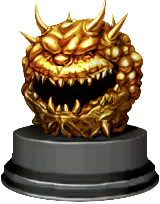 Wormwood V - @Ribbiks & @Grain of Salt
Wormwood V - @Ribbiks & @Grain of Salt
Doom 2, Boom-compatible, 5 maps
For the past six years, Ribbiks and Grain of Salt have been gifting us mad science experiments on Halloween in the form of the Wormwood series and its orange-loving prequel. Out of them all, Wormwood 5 comes together as the most fully realized experiment, rolling the proverbial dice every time the player launches it, aiming to give them an experience they didn't have the last time.
An axe murderer lost in his own horror movie is Doomguy, this time. He finds himself breaking through the walls, never coming out in the same place each time, falling deeper and deeper into the depths of an inescapable wooden resting place. There's something about the music, he finds -- records don't sound like that...and those paintings...There's something wrong with them.
Where Grain of Salt's ominous opener introduces the dice mechanic that the rest of the WAD stands behind, her second map puts it fully into play -- shuffling the locations of the player's arsenal and power-ups amid a bleak landscape surrounding a central fort. The player retains only a handful of specific tools on a given attempt, to provide them with a metaphorical anchor against the hordes that will close in on them. It asks the player how they will adapt when the weapons they're given aren't always what they've grown to expect -- though they are always welcome to fall back on their established axe-murdering tendencies, using a melee starter weapon that can one-shot revenants and three-shot the low-HP cyberdemons you'll encounter.
Then there's the byzantine After Image with all of its occult gimmicks involving curse levels, a map that easily eclipses Ribbiks's other Wormwood centerpieces. As grand as it is, After Image left us with the refreshing feeling of restraint. The layout could have easily held twice as many big encounters as it did, but the relative sparseness provides room for later replays to fully experience the intricacies of the wad's mechanics, rather than wearing the player out forever after one go. It also allows the mood of horror to perfuse through the gothic megafortress and its surrounding environment -- providing a very real feeling that you're at the remote edge of the world and everything might be a transient mirage.
The curse levels, which rise as you pick up weapons, recall how modern challenge wads have tended to feature obscure but rewarding optional content -- one foundational trope being the secret sidequest that gates a BFG behind a gauntlet of extra hard encounters. Some authors would then add extra enemies to any not-yet-beaten mainline fights once you have 'leveled-up', keeping those encounters more suited to your power level. But the possible downside is that this mechanic would happen silently, possibly throwing off the player's understanding of the map. After Image reads as this trope being folded into a map-defining motif heavily intertwined with the map's gothic aesthetic. Placards situated around the wasteland show you how cursed you are, thus explaining where all the extra enemies come from and that this is happening at all.
There's just a dazzling array of cool concepts in this wad, but even beyond all those concepts, this is both authors not too far away from their fundamental best, both in the gameplay and visual department. Ultimately, it felt like Wormwood V cared just as much about serving up fun, enjoyable combat and a holistically strong experience as it cared about its core gimmicks. Grain of Salt's tone-setting haunted house excursion and dice-rolling fort liberation work in tandem with Ribbiks's grand vision of occult magic Doom experiments -- all brave efforts in making sure the player has to think on their feet, and not cower in fear of the unknown.
-
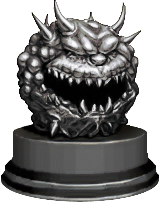 The Diseases, and Casualties of This Year Being 1632 - Various
The Diseases, and Casualties of This Year Being 1632 - Various
Doom 2, Boom-compatible, 11 maps
Well, folks, if you were asking yourselves just what this mouthful of a name could possibly allude to, worry not, for I have the receipt! The title references a newspaper pamphlet from 1632, listing out diseases and casualties of that year. No, I’m not kidding. With the mystery surrounding one of the most bizarrely named PWADs of the year out of the way, though, another question lingers: just what can you expect out of such a mapset?
The mappers took full advantage of the “In Name Only” theme with this unique project, picking out a random cause of death from the list and creating a full fledged map. For instance, “Teeth” by Dieting Hippo has the player circle around fleshy landscapes with more gnarly fangs and dental implants than the most expensive dentist office in town. Or, as another example, the map “Kil’d by several accidents” by A.o.D presents itself as a large map of many themes, throwing the player from techbases to sewers and finally into Hell, in a rhythm that makes sense one moment and loses itself into madness the next. Erratic progression is a prominent theme in most if not all of the maps, and even if some maps may seem predictable in what might happen next, they will most definitely surprise you.
The levels are mostly small to medium sized, with a couple of large and imposing maps thrown into the mix, meaning there'll be much to like here by players of diverging tastes. There are all sorts of battles and ambushes awaiting the player – some maps throw you straight into the action, and others will have you walking in apparent solitude in a dark base, except you’re very much not alone. All of this is also achieved without using a single custom texture, utilizing the vanilla assets as skillfully as possible.
A mapset that has such a name behind it can be anything but plain, and it sure holds true. The crew behind it made sure it’s chock full of surprises, and you can never know what kind of disease, or casualty may befall upon thee.
-
 Godless Night - @Tango et al.
Godless Night - @Tango et al.
Doom 2, GZDoom, 10+ maps
If there's a reliable formula for Doom modding magic, I'd like to believe it's a conflux of complementary inspirations handled by folks with the experience and talent to respect them. Take Castlevania, a venerated series since the early days of console gaming with its gothic horror aesthetic and addictive action/platforming gameplay... sadly, it has since receded into the night, with the last mainline release being nearly a decade ago, but its legacy lives on in the Bloodstained game series led by former producer Koji Igarashi, a few animated Netflix shows and the DNA of innumerable games affectionally labeled "Metroidvania". Then, we have Supercharge, Tango's acclaimed Doom gameplay mod that amps up the action with instant weapon switching, a punchier arsenal, new creatures to combat and numerous audio/visual frills. It's a sweet symphony of visceral satisfaction that could spice up any map set, so with these two titans of action entertainment, was there any doubt that their integration would be good? Unlikely, but the result rose above my wildest expectations and became one of the most welcome surprises of the year.
Godless Night is a Supercharge-powered, hub-based GZDoom episode with the polish and presentation of a full studio production. Shortly after picking one of the carefully calibrated difficulty settings in the opening antechamber, you appear before the Gallerist's Keep on a foreboding night, bathed in eerie moonglow. Most ostensibly taking after Portrait of Ruin, the castle and surrounding landscape contain a prized collection of portals leading to towers filled with mechanized marvels, sunken sanctuaries, crumbling catacombs... the mainstay Castlevania backdrops, each immaculately detailed and masterfully interconnected. Tango and company composed a harmony of delights in the mod's pacing, linking bursts of incidental combat with some inventive scripted fights - call these the mod's mini-bosses. Imagine keeping the Hellish hordes at bay while dodging the shells of unreachable grenadiers, dancing illusions around the multitudes while avoiding a hotfoot from the diabolist's fire, and much more. Add in some choice midi renditions of classic Castlevania tunes and you have a feast for the ears as well as the eyes.
Being hub-based, continuous play is required, which not only works to your advantage but emulates a true Metroidvania. Hellspawn-hunters can power through the encounters to conquer the castle, or they can take in the sights and revisit old chapters to collect more supplies and scrounge for secrets. New armaments could be preambles or rewards for heavy encounters, but vigilant treasure seekers may unearth unique demon-slaying ordnance not offered elsewhere. Levels cleared of monsters and secrets will trigger a satisfying fanfare, but that's not all - "perfect" enough portraits and Ruin mode is unlocked, acting as a New Game+ with remixed visual themes, ultraviolent challenges and some nifty surprises. It's these extra touches and commitment to quality that makes this set feel like the complete package - an immensely satisfying experience that rewards your time and encourages replays.
Supercharge, personally, was already among the best reasons to boot up GZDoom and Godless Night instantly became my favorite set to utilize it, melding elements of the familiar into a phenomenal new adventure that I played and immediately replayed upon finishing. What a wonderful night to have a blessing.
- @Vile
-
Doom 2, vanilla-compatible, 10 maps
The Squonker Crew are at it again! After delivering us five entire mapsets last year, of which Pagodia was a runner-up, the team took their time crafting and refining their next gem, Tetanus.
Immediately after booting the wad file, the player is greeted by a very specific array of colors – stacks of rusty orange boxes, a soothing azure sea and sky, gray walls and mossy green rocks. These four colors are the backbone of the project, as it is highly inspired by “orange-box” types of games from the source engine, at least when it comes to visuals, sending the player forth towards all sorts of outdoor bases, dark jungles and the like.
Tetanus doesn't only excel at the visual department – each mapper is experienced in all sorts of different gameplay loops, and the mapset challenges the player with non-stop run n' gun action. There's plenty of different combat styles showcased in this wad – from short and punchy maps by Egg Boy, to an amusing barrel-centric map by Uber, as well as Bobby J's open-plan slaughter-lite final map that ended the set on a note of catharsis, and so much more.
One of the WAD's standouts is “Salvage” by AD_79 – a map that has already made its influence felt this year by inspiring the birth of a project based around the same theme, which takes place in an underwater base and has the player blast through the hordes of hell while gasping for air. The mix of relaxing incidental combat, high-intensity traps, and time pressure combat based around the diving suits arguably makes this map the most memorable one in the set.
The longer build time sure is felt – compared to previous Squonker releases that may have felt like speed maps, Tetanus gives the impression of a refined, well-processed project in all possible aspects. Whether it's the clean design choice, the cunningly choreographed gameplay, or the almost entirely bespoke soundtrack by AD_79 and ZeMystic – all of the above are a product of the crew’s love of the game, culminating into one of the highest quality mapsets that the Squonker Crew has released thus far. And to think this bad boy runs on vanilla Doom!
-
Doom 2, MBF21-compatible, 3 maps
In his release thread, lunchlunch self-deprecatingly presents his follow-up to last year's 10x10 Project as a release styled after so many challenge wads -- like Fractured Worlds, Newt, Miasma, and Abandon. While this accurately places the niche, it definitely understates its unique qualities. For one thing, Jaded is among the most tonally distinct such wads in recent times. Presenting a technogothic megafortress and its surrounding jewel-studded wilderness under the starry sky and Cammy's relaxing background music, it's downright soothing -- rather than exploring the oppressive or despairing or obscurantist vibe that is more common in this niche. Even a detail as simple as how Jaded sandwiches its central megamap between an ambient opener and a cathartic mini-challenge closer opens up formal possibilities that standalone megamaps don't have, such as how the centerpiece map begins in the heat of action, inside a big imp-gibbing rocketfest.
I appreciated Jaded aesthetically for a similar reason as I did Eviternity's "Cryonology" (and no, they don't share any influence). The two do however share gorgeously peaceful backing MIDIs; grand, sweeping architecture that creates beautiful far-ranging vistas; and big contrasting planes of color that can hit you all at once. The combat -- despite not dipping into innovative concepts and mechanics (a big difference from Fractured Worlds...) or calling for obscure strategies (...from Abandon) -- is engaging anyway, situated almost exclusively in arenas shaped to make circle-strafing or easy U-strafing impossible. Jaded's combat is persistently good at "layeredness" -- you might be fighting one group nearby, but need to mentally track dangerous threats in the background or far away. It amounts to a gameplay mode that can be fun and inviting to less experienced slaughter players, but still challenging enough for veterans trying to complete a run.
What glues this together is the way lunchlunch knows himself: he's not one to aimlessly veer away from the logic he's established within a map. This ties into his tendency towards personal tropes (such as how secrets give you SS Nazis to destroy again), which is ultimately what elevates Jaded well past imitation. Because even when working in established traditions, sometimes you can't help but be yourself.
- @rd.



